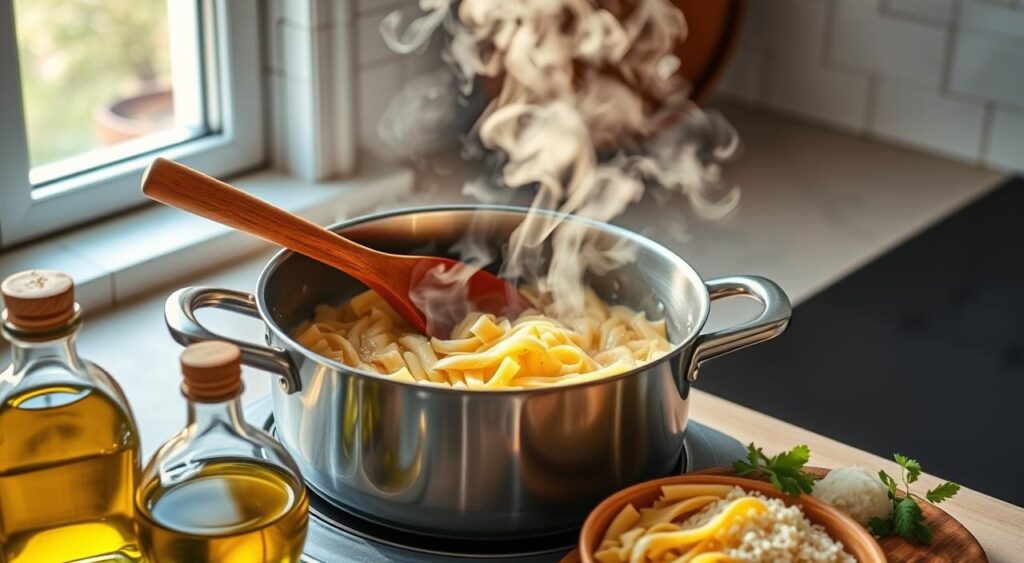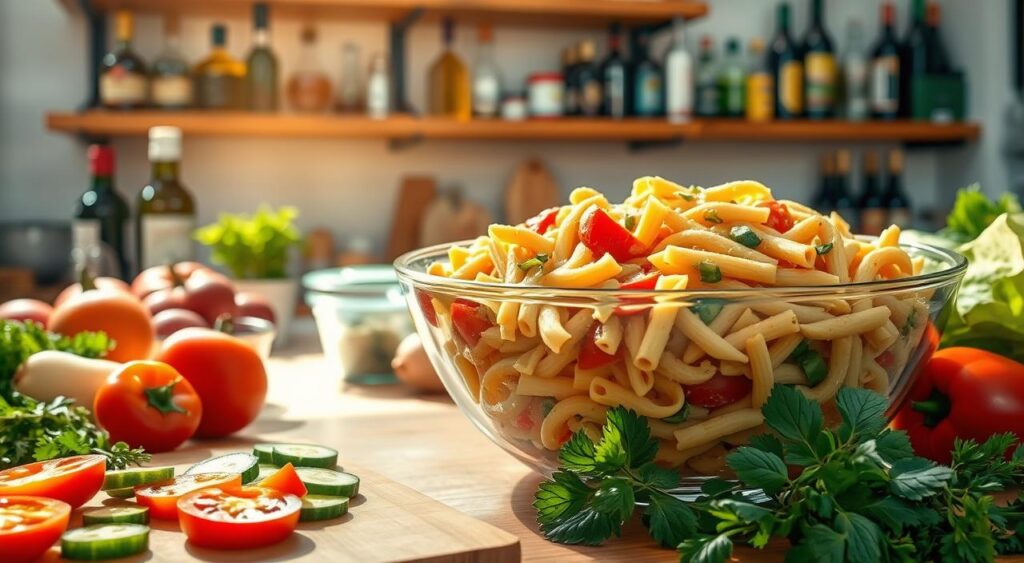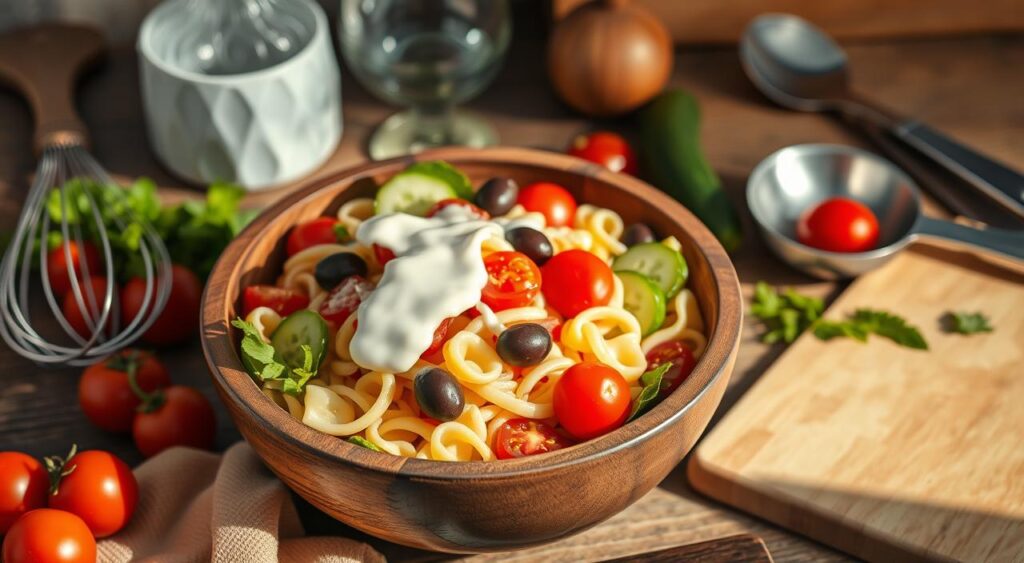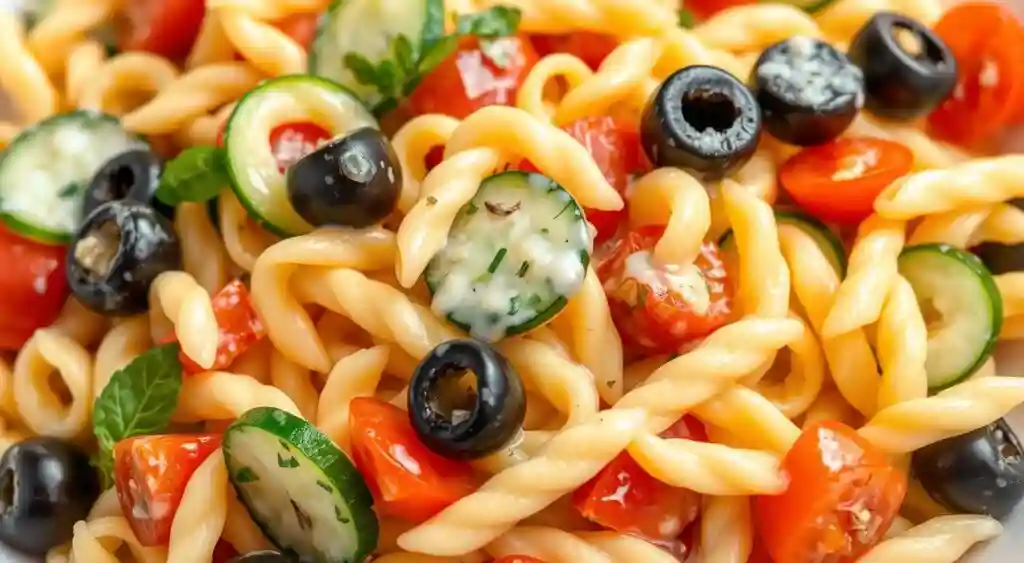Have you ever found yourself reminiscing about those special summer gatherings where the tables were filled with delicious dishes that brought everyone together? For many of us, a delicious summer pasta salad is one of those staples that evoke joyful memories of laughter, shared stories, and a sense of community. And there’s something undeniably special about a pasta salad with Olive Garden dressing that takes those cherished memories to the next level. It’s zesty, flavorful, and a true winner at any barbecue or potluck.
This Olive Garden copycat recipe not only promises a burst of flavor, but it’s also incredibly easy to prepare. Whether you’re looking to impress at your next gathering or simply want to treat yourself to a delightful meal, this pasta salad will soon become your go-to recipe. Let’s dive into what makes this dish an unforgettable addition to your culinary repertoire.
Table of Contents
Introduction to Pasta Salad with Olive Garden Dressing
When it comes to creating the best pasta salad, the addition of Olive Garden dressing makes all the difference. This zesty and flavorful dressing turns a simple pasta salad into a culinary delight, perfect for various occasions.
Why It’s a Fan Favorite
One of the primary reasons this dish is so adored is the flavor of Olive Garden dressing. It blends well with the ingredients, creating a harmonious taste that’s hard to resist. This easy pasta salad recipe is not just about convenience but also about satisfaction. For many, it’s the delicious pasta salad with Olive Garden dressing that stands out amidst other recipes.
Perfect for Any Occasion
From family dinners to potlucks, this best pasta salad fits seamlessly into any event. Its versatility allows it to complement a range of main dishes. Whether you are preparing an easy pasta salad recipe for a casual get-together or a more formal affair, it never disappoints. The crowd-pleasing nature of this delicious pasta salad with Olive Garden dressing ensures it will be a hit wherever it is served.
Ingredients Needed for the Ultimate Pasta Salad
To create the ultimate pasta salad with the quintessential Olive Garden touch, you’ll need to gather a mix of vibrant, fresh pasta salad ingredients. The foundation starts with tricolored rotini pasta, which adds not only texture but a pleasing visual element to your dish. Next, select ripe, juicy vine tomatoes and crisp English cucumbers to lend a refreshing crunch.
Red onions are another vital addition, delivering a bit of zing that balances the flavors, while parmesan cheese provides a rich, creamy taste that ties everything together. However, what truly elevates this salad is the signature Olive Garden Italian dressing. If you’re keen on a DIY approach, you can also whip up a homemade olive garden dressing for pasta salad, ensuring a truly personalized taste experience.
Optionally, you can enhance the overall flavor profile by adding a zesty Italian dressing mix and incorporating a variety of fresh, colorful vegetables. The combination of these high-quality pasta salad ingredients ensures a vibrant, delicious dish that’s perfect for any occasion.
Choosing the Right Pasta for Your Salad
Picking the best pasta for salad can elevate the dish’s overall taste and texture. Each type of pasta offers unique attributes that pair excellently with different ingredients and dressings. When considering your options, always keep in mind the ability of the pasta to hold onto the dressing and other components.
Types of Pasta to Use
Several varieties of pasta work well for a pasta salad, including:
- Fusilli
- Penne
- Farfalle
Among these, rotini pasta is often regarded as one of the best pasta for salad due to its spiral shape, which makes it perfect for trapping and holding onto the dressing.
Why Rotini is a Great Choice
Rotini is a fantastic option for an Italian pasta salad, particularly when paired with Olive Garden dressing. Its twirled shape ensures that each bite is flavorful, making it a crowd-pleaser for any gathering.
| Pasta Type | Features | Best For |
|---|---|---|
| Fusilli | Spiral-shaped | Holding thick dressings |
| Penne | Tubular | Mixed salads |
| Farfalle | Bow-tie shape | Light salads |
| Rotini | Curled spirals | Flavor retention |
Vegetables to Include in Your Pasta Salad
When it comes to creating a delicious and fresh customizable pasta salad, the choice of vegetables is paramount. Using fresh vegetables for salad not only adds vibrant colors but also enhances the flavor profile of the dish. Here, we explore the essential vegetables you should consider including, along with some optional add-ins that can elevate your pasta salad to the next level.
Tomatoes
Ripe, vine tomatoes are a staple in any pasta salad. They provide a sweet, juicy burst of flavor that complements the other ingredients. Cherry or grape tomatoes are particularly excellent choices as they are bite-sized and less likely to become mushy.
Cucumbers
Crisp English cucumbers add a refreshing crunch to your customizable pasta salad. Their mild flavor balances the richness of other components, offering a light and healthy contrast that is integral for a well-rounded pasta salad.
Optional Add-ins: Onions, Peppers, and More
To personalize your fresh vegetables for salad, you can include finely diced red onions, green bell peppers, and even black olives. These add-ins provide additional layers of flavor and texture, allowing you to tailor your pasta salad to suit personal preferences. Whether you’re looking for a bit of spice or a touch of sweetness, these ingredients can help you achieve the perfect balance.
Adding Cheese and Protein to Your Pasta Salad
Enhance your pasta salad by incorporating a variety of cheeses and proteins that not only add delicious flavors but also transform it into a hearty and protein-packed pasta salad. From rich cheeses to savory meats, these ingredients can elevate your dish to a whole new level.
Cheese Options: Parmesan, Provolone, Mozzarella
A critical component for a delightful pasta salad is the cheese. Opting for different cheeses provides layers of taste and texture:
- Parmesan: This hard, aged cheese offers a sharp, nutty flavor that’s perfect for grating over your salad.
- Provolone: Known for its smooth texture and mild flavor, provolone can be sliced or cubed for a creamy bite.
- Mozzarella: This soft cheese boasts a mild taste and a wonderful, chewy texture. Fresh mozzarella balls or shredded mozzarella work equally well.
Including Proteins: Salami, Pepperoni, Chicken
Adding proteins can turn your pasta salad into a more complete and fulfilling meal. Here are some excellent choices:
- Salami: Thin slices or small cubes of salami bring a spicy, robust flavor that pairs perfectly with the mildness of the cheese in pasta salad.
- Pepperoni: Another great option, pepperoni offers a zesty taste that complements the other ingredients remarkably well.
- Chicken: Grilled or baked chicken breast adds lean protein, making your salad a more protein-packed pasta salad.
| Cheese | Description | Usage |
|---|---|---|
| Parmesan | Hard, nutty, sharp | Grated over salad |
| Provolone | Smooth, mild | Sliced or cubed |
| Mozzarella | Soft, mild | Fresh balls or shredded |
How to Cook Perfect Pasta for Salad
Mastering the art of cooking pasta for use in a salad can elevate your dish to new heights. Follow these guidelines to ensure your pasta is perfectly prepared for your recipe.
Boiling Tips
One of the essential pasta boiling tips is to bring your water to a rolling boil before adding the pasta. This will help ensure even cooking. Generously salt the water, which enhances the pasta’s flavor from the start. Use a large enough pot to allow the pasta to move freely, preventing it from sticking together.
Seasoning Your Water
Seasoning your water is crucial when cooking pasta al dente. Add a substantial amount of salt, akin to seawater’s salinity. This step infuses the pasta with flavor before it even meets the dressing, making your pasta salad taste more vibrant.
Cooking Time for Al Dente Pasta
Follow the cooking time specified on the pasta package, but start checking for doneness two minutes earlier. The perfect al dente texture is achieved when the pasta is tender yet firm to the bite. This cooking timestep ensures that the pasta holds up well when mixed with other ingredients and dressing.
After boiling, promptly drain the pasta and rinse it with cold water to halt the cooking process and remove excess starch. This step is pivotal in achieving light and non-sticky pasta, ideal for salads.

Preparing the Vegetables
Ensuring your pasta salad bursts with flavor begins with understanding how to prepare vegetables correctly. Fresh ingredients play a vital role in creating a delightful dish. Start with a variety of vegetables like tomatoes, cucumbers, and onions. These should be freshly diced to maintain their crunch and flavor.
Focus on keeping the vegetables vibrant and appealing. Lightly season the vegetables with salt before combining them with the pasta. This enhances their natural flavors, making the salad even more enjoyable.
Here is a quick guide on the essential fresh ingredients you will need:
| Vegetable | Preparation Method | Tip |
|---|---|---|
| Tomatoes | Diced | Choose firm, ripe tomatoes for best results |
| Cucumbers | Sliced | Use English cucumbers to minimize seeds |
| Onions | Chopped | Red onions add a colorful punch |
Mixing the Olive Garden Dressing
Creating the perfect Olive Garden dressing pasta salad involves crafting a zesty pasta salad dressing that tantalizes your taste buds. While the signature dressing from Olive Garden is a favorite, you can also explore homemade pasta salad dressing options for a personalized touch.
The Secret Zesty Mix
The key to achieving a flavorful Olive Garden dressing pasta salad lies in the combination of Olive Garden dressing with a dry zesty Italian mix. This duo forms the base of the zesty pasta salad dressing, offering a delightful balance of bold and tangy flavors. Simply mix these ingredients thoroughly to ensure that each bite of your pasta salad is richly coated.
Alternative Dressing Options
If you’re looking to customize your pasta salad even further, consider alternative dressing options. A homemade pasta salad dressing can be made by blending olive oil, vinegar, and a mix of Italian herbs. Alternatively, you can explore different store-bought brands to find one that suits your preferences. Each option allows you to tailor your dish to your taste while maintaining the classic charm of an Olive Garden dressing pasta salad.
| Dressing Type | Flavor Profile | Best Use |
|---|---|---|
| Olive Garden Dressing + Zesty Italian Mix | Bold and Tangy | Classic Pasta Salad |
| Homemade Italian Dressing | Fresh and Herby | Customized Flavors |
| Store-bought Italian Dressing | Varied | Convenient and Quick |
Combining All Ingredients Together
One of the most exciting parts of learning how to make pasta salad is the final step where all the ingredients come together. It’s in this phase that the real magic happens, ensuring a flavorful and satisfying dish.
The Right Way to Toss
To begin, place all your prepared ingredients—pasta, vegetables, cheeses, and proteins—into a large mixing bowl. Gently but thoroughly toss them to ensure that each component is evenly coated with the delicious Olive Garden dressing. Proper tossing is crucial for mixing pasta salad perfectly, preventing certain sections from becoming too heavy with dressing while others remain dry.
Ensuring Even Distribution
For an even distribution of flavors and textures, take your time when mixing the ingredients. Use a large spoon or tongs to lift and mix, making sure not to crush delicate ingredients like tomatoes and cheese. The goal is to have each bite bursting with a balanced blend of tastes.
Chilling and Marinating Your Pasta Salad
To achieve the best flavors in your pasta salad, chilling and marinating are essential steps. By following these guidelines, you will elevate the taste and texture of your dish.
Refrigeration Tips
After combining your ingredients, it’s crucial to place the pasta salad in the refrigerator. Chilling pasta salad for at least one hour ensures the elements bind well. This resting period also allows the flavors to meld together, offering a more unified taste experience.
Ideal Time for Marinating
For those who want an even more intense flavor profile, marinating pasta salad overnight is highly recommended. This extended marinating period deepens and enhances the flavors, resulting in a truly delectable pasta salad. Whether you prefer a quick chill or an overnight marinade, these steps will ensure your pasta salad is both refreshing and delicious.
Serving Suggestions for Pasta Salad with Olive Garden Dressing
Adding a summer pasta salad with Olive Garden dressing to your menu elevates any dining experience. Not only does it offer a refreshing taste, but it also pairs beautifully with a variety of main dishes, making it versatile for numerous dining occasions.
Pairing with Main Dishes
When considering pasta salad serving suggestions, grilled meats are an excellent choice. Think about serving it alongside juicy grilled chicken, savory steaks, or succulent pork chops. The robust flavors of the grilled meats combined with the zesty and refreshing summer pasta salad create a harmonious balance that delights the palate.
Best Occasions to Serve It
The versatility of a summer pasta salad with Olive Garden dressing makes it suitable for various events. It’s an ideal dish for outdoor summer parties, potlucks, picnics, and cozy indoor gatherings. The ease of preparation and the ability to scale the recipe to cater to larger groups make it a go-to side dish. Whether celebrating a holiday, a birthday, or simply enjoying a weekend barbecue, this salad is guaranteed to complement your main dishes and please your guests.
Tips for Making the Best Pasta Salad
Creating the best pasta salad recipes involves more than just tossing ingredients together. Attention to detail, especially when it comes to seasoning and avoiding common pitfalls, is key to achieving a vibrant, flavorful dish.
Seasoning Secrets
One of the essential tips for perfect pasta salad is to properly season both the pasta cooking water and the salad itself. Salting the water during cooking ensures the pasta is flavorful even before adding other ingredients. When preparing the salad, consider including a variety of herbs and spices like basil, oregano, and a pinch of red pepper flakes to add an extra layer of taste.
Common Mistakes to Avoid
Several errors can sabotage your best pasta salad recipes. Overcooking the pasta is a major one, leading to a mushy texture that fails to absorb dressings and other flavors. Similarly, dressing the pasta too early can result in a soggy salad. Instead, dress the pasta while it is still warm to maximize flavor absorption. Ensure even distribution of dressing and other ingredients to achieve a cohesive and balanced taste in every bite.

Storing and Shelf Life of Pasta Salad
Properly storing pasta salad ensures it retains its freshness and flavor for several days. When you finish preparing your pasta salad, place it in an airtight container to maximize its *shelf life*. It’s crucial to keep the salad refrigerated to prevent bacterial growth, which can occur if left at room temperature for extended periods.
To help you effectively manage the storage, here are the key factors to remember:
- Always use an airtight container.
- Refrigerate immediately after preparation.
- Consume within 4-5 days to enjoy optimal taste and texture.
- Avoid leaving the pasta salad out of the fridge for more than two hours.
Here’s a detailed breakdown of *pasta salad shelf life* based on storage conditions:
| Storage Condition | Duration |
|---|---|
| Refrigerated (Airtight Container) | 4-5 Days |
| Room Temperature | Up to 2 Hours |
By adhering to these best practices for *storing pasta salad*, you can enjoy its fresh and vibrant flavors for days to come.
Variations and Customizations
Creating the perfect pasta salad means tailoring it to your tastes and dietary needs. Whether you’re aiming for a Mediterranean twist, a vegetarian delight, or a version that’s perfect for the kids, you’re in control of the ingredients. Here are some inspired variations to get you started.
Mediterranean Style Pasta Salad
For a mouthwatering Mediterranean pasta salad, consider adding Kalamata olives, cherry tomatoes, cucumbers, and feta cheese. You can also throw in some artichoke hearts and roasted red peppers for extra flavor. Drizzle with a tangy olive oil and lemon dressing to complete this flavorful, Mediterranean-inspired dish.
Vegetarian Options
A delicious vegetarian pasta salad can be created by omitting meats and increasing the variety of fresh vegetables. Think zucchinis, bell peppers, and spinach for a colorful and nutritious mix. Adding chickpeas or lentils provides a protein boost, making your vegetarian pasta salad both filling and enjoyable.
Kid-Friendly Versions
A kid-friendly pasta salad should focus on simple flavors and mild cheeses. Use ingredients such as mozzarella cubes, cherry tomatoes, and steamed broccoli. Avoid spicy ingredients and opt for a creamy dressing that’s appealing to young palates. This approach ensures your pasta salad is both tasty and approachable for children.
Frequently Asked Questions
Many readers have questions regarding the preparation of the ultimate pasta salad. Here are some pasta salad FAQs to help you prepare a delightful dish effortlessly.

A: Absolutely! Making the pasta salad a day in advance allows the flavors to meld together. Just be sure to store it in an airtight container in the refrigerator.
Q: What are some good ingredient substitutions?
A: If you’re out of a particular vegetable, feel free to swap it with bell peppers, olives, or artichoke hearts. For cheese, feta or gouda can be great alternatives to mozzarella.
Q: How do I keep the pasta from getting too soft?
A: To prevent mushy pasta, cook it to an al dente texture by following the recommended cooking times on the package and then immediately rinsing it under cold water to halt further cooking.
Q: What’s the best way to serve a quick and simple pasta salad?
A: Serve your pasta salad chilled, especially during warm weather. It pairs beautifully with grilled chicken or as a standalone main course for a light meal.
Q: Can I add extra protein to my pasta salad?
A: Yes, adding proteins such as grilled chicken, shrimp, or even tofu can make your pasta salad more filling and nutritious.
We hope these insights from our pasta salad FAQs will help you craft a delicious and hassle-free dish. Enjoy experimenting with different variations to find your perfect blend!
Conclusion
In summary, making pasta salad at home with Olive Garden dressing opens the door to a world of easy pasta salad ideas that are both delicious and versatile. This dish stands out due to its adaptability, allowing you to customize it according to your taste preferences and dietary needs. Whether you opt for Mediterranean flavors, vegetarian options, or kid-friendly versions, the pasta base paired with the zesty Olive Garden dressing will never disappoint.
One of the most significant advantages of this recipe is its suitability for various occasions. From casual family dinners to lavish get-togethers, this pasta salad fits seamlessly into any menu. The combination of fresh vegetables, pasta, and a flavorful dressing ensures that you have a wholesome meal that everyone will love.
Finally, the convenience of making pasta salad at home cannot be overstated. With simple steps and readily available ingredients, you can whip up a quick and satisfying meal. By following this guide, you are well-equipped to create a pasta salad that will be a hit time and time again, proving that easy pasta salad ideas can indeed result in gourmet-level dishes.
FAQ
What are the main ingredients for a pasta salad with Olive Garden dressing?
The main ingredients include tricolored rotini pasta, vine tomatoes, English cucumbers, red onions, parmesan cheese, and Olive Garden dressing. Additional flavors can be incorporated with a zesty Italian dressing mix and a variety of fresh vegetables.
What type of pasta is best for pasta salad?
The best types of pasta for pasta salad are those that can trap and hold dressing well, such as rotini, fusilli, penne, and farfalle. Rotini is particularly popular due to its spirals which are excellent at holding dressing.
How do I prepare the pasta for the salad?
Bring water to a rolling boil and season generously with salt. Cook the pasta according to the packaging instructions until it is al dente, ensuring it retains a slight bite for better texture when mixed with other ingredients and dressing.
How should I prepare the vegetables for the pasta salad?
Ensure vegetables like tomatoes, cucumbers, and onions are freshly diced to maintain their crunch and flavor. Lightly season them with salt to enhance their natural flavors before combining them with the pasta.
What cheese options work best in this pasta salad?
For a rich flavor profile, you can use cheeses such as parmesan, provolone, and mozzarella.
Can I add protein to the pasta salad?
Yes, you can incorporate proteins like salami, pepperoni, or cooked chicken to make the pasta salad more filling.
How do I make the dressing for the salad?
Combine Olive Garden dressing with a dry zesty Italian mix for the base. You can also use a homemade Italian dressing or a different store-bought brand if desired.
How long should I chill the pasta salad before serving?
Chill the pasta salad in the refrigerator for at least one hour before serving. For optimal taste, let it marinate overnight to enhance the depth of flavors.
How should I store leftover pasta salad?
Store the pasta salad in an airtight container in the refrigerator. Properly stored, it can last for 4-5 days.
What are some variations I can try with this pasta salad?
You can try a Mediterranean twist by adding olives and feta cheese, or a vegetarian version by omitting meats and adding more vegetables. Kid-friendly versions can feature milder cheeses and fewer spicy ingredients.


1 thought on “The Ultimate Pasta Salad with Olive Garden Dressing Recipe”